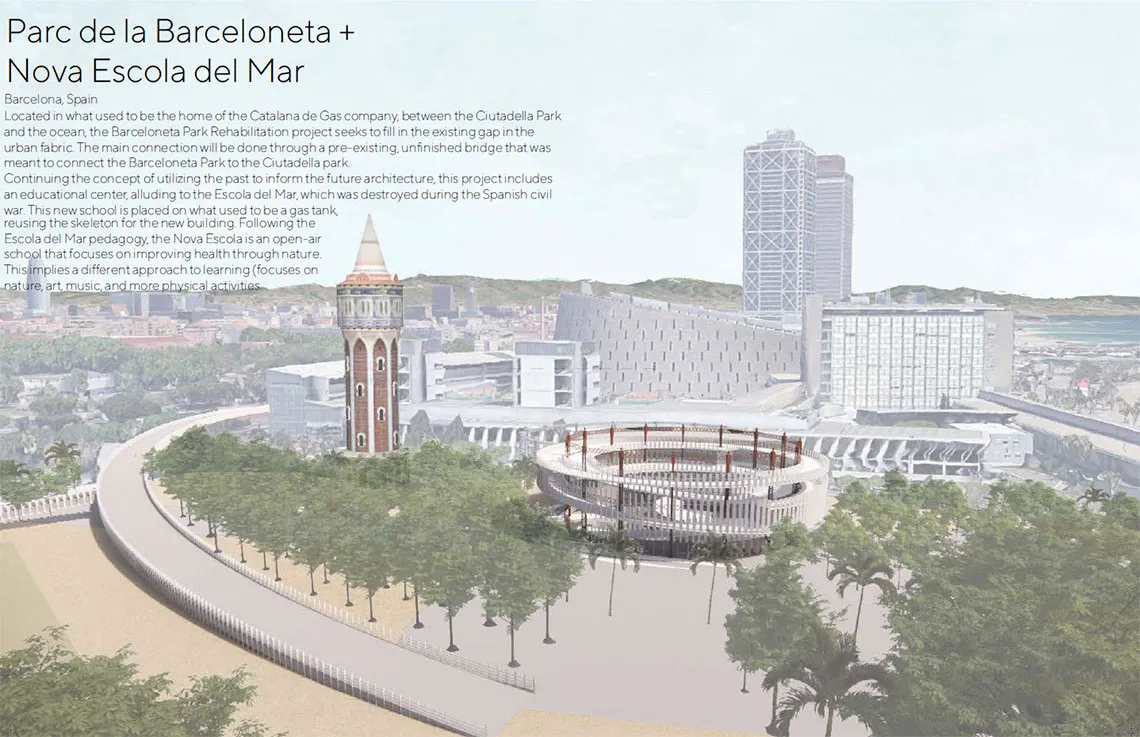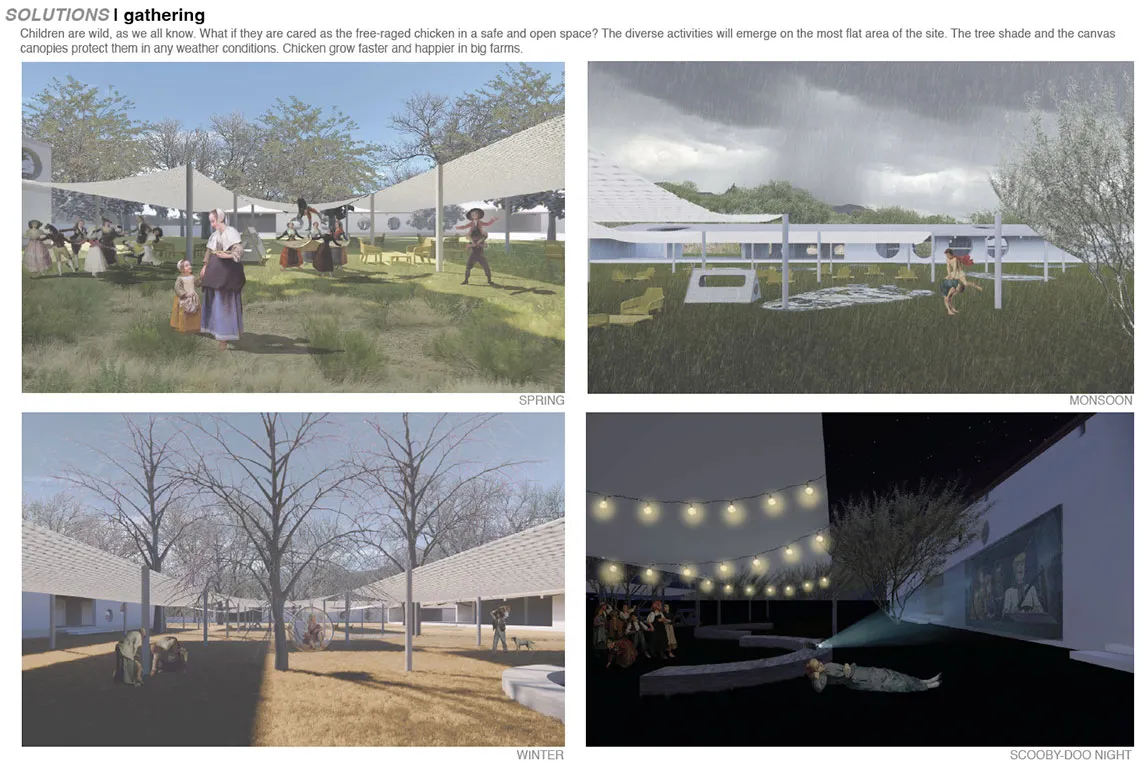Richärd Kennedy Fourth Year Prize Propels Bachelor of Architecture Students into Fifth and Final Year

Librillo, a fourth-year plan digital drawing by Sam DeBartolo, whose portfolio won the 2021 Richärd Kennedy Fourth Year Prize Honor Award.
The semester before their final year in the University of Arizona’s NAAB-accredited, five-year Bachelor of Architecture program, students have the opportunity to reflect on their learnings over their first four years and put their best work forward in an exhibition and portfolio competition.

Sam DeBartolo '22 B Arch.
In Spring 2021, the Richärd Kennedy Fourth Year Prize at the College of Architecture, Planning and Landscape Architecture provided $10,000 in portfolio awards and scholarships for these B.Arch students.
Founded in 2015 as the Richärd+Bauer Prize, the portfolio prize offered by Phoenix-based Richärd Kennedy Architects (formerly Richärd+Bauer Architecture) is based on overall project and presentation excellence. In the former, the focus is quality, relevance and comprehensiveness of the student’s project proposal. In the latter, judges seek clarity, vision and persuasiveness of the project presentation. Fourth-year option studio faculty members Professor of Practice in Architecture Elena Cánovas and Assistant Professor of Practice in Architecture Teresa Rosano coordinated the exhibition and jury selection.

Sam Owen '22 B Arch.
“Open portfolio parameters allowed students to express themselves and their developing points of view, and showcase their work in a manner of their choosing,” says Rosano. “Some highlighted their entire journey through school to date. Others opted to delve deeply into one recent project and explain how their education so far had propelled them in that direction and informed that emphasis.”
This year, four B.Arch were selected as portfolio award recipients: Sam DeBartolo (Honor Award), Sam Owen (Merit Award), Estefania Peña (Honorable Mention) and Vincent Yang (Honorable Mention).

Estefania Peña '22 B Arch
“In many ways the work I have done feels as if it is a gift rather than my own thoughts, and validation that this work means something to others humbles and excites me,” says DeBartolo, who took home the top prize.
Judges Elena Rocchi of Arizona State University, Amal Anoohi ‘19 B.Arch, and David Kim ‘14 B.Arch, ‘20 Harvard GSD agree: “[DeBartolo’s portfolio] is like a good book: the desire to read it grows as we scroll through the pages without words, but beautiful drawings as the story of one’s experiences and professional skills are well done. It displays a sense of maturity, personal style, excellent creative expression and an assertive attitude towards design principles throughout.”

Vincent Yang '22 B Arch.
“We are grateful to Richärd Kennedy for this generous prize,” says CAPLA Dean Nancy Pollock-Ellwand. “The prizes, scholarships and recognition mean so much to our students—and to the college and university.”
Pollock-Ellwand also extends her thanks to the exhibition and prize coordinators, who in addition to Cánovas and Rosano are Assistant Professor of Architecture and Sustainable Built Environments Jonathan Bean and University Distinguished Professor of Architecture Mary Hardin.
For Rosano, the work submitted by the fourth-year students speaks not only to the students’ hard work and design skills, but also the exhibition’s significance for other architecture students. “Philosopher John Dewey writes, ‘We do not learn from experience... we learn from reflecting on experience.’,” she says. “As rising fifth-years about to embark on their capstone projects, this chance for self-reflection serves to empower students as they relive their learning and accomplishments. The exhibition celebrates their intense effort from their first four years and provides inspiration and exemplars to other students.”
View all Spring 2021 Richärd Kennedy Fourth Year Portfolio Prize submissions and meet the judges.
Q&A with Richärd Kennedy Fourth Year Portfolio Prize Winners

Fourth-year Design + Build Group Project render from portfolio by Sam DeBartalo.
Sam DeBartolo ‘22 B.Arch
Tell us about your portfolio and your design approach and evolution as a designer.
This portfolio was about curating a timeline of all my work throughout my experience in architecture school, highlighting the projects which most accurately reflect what I have been seeking for the last four years. Though I am just beginning, this work clarifies the qualities of space that I am striving after to craft an architecture of human experience.
What elements of architecture are you most interested in?
Attention to qualities of experience is at the core of each of these projects, as I seek what is good, true and beautiful through the lease of human activity.
Why is winning the portfolio competition important to you, and how will it help you in your final year in the B.Arch program?
Winning the competition was a humbling honor, and I appreciate the generosity of Richärd Kennedy to set up this provocation to students. I found this competition engaging and encouraging. In many ways the work I have done feels as if it is a gift rather than my own thoughts, and validation that this work means something to others humbles and excites me.
What are your post-graduation career or education plans?
I would like to attend graduate school somewhere else in the world to have a vastly different experience than my life lived in the Southwest. However, I am open to working for a year to gather more experience if graduate school is not the immediate answer.

Sonoita House Site Model from portfolio by Sam Owen.
Sam Owen ‘22 B.Arch
Tell us about your portfolio and your design approach and evolution as a designer.
Anyone who knows me knows that I’m a very thorough person, and my portfolio definitely reflects that. In my studio work I try to address projects from every possible angle, so my consistent challenge in assembling a portfolio is to distill a plethora of information that I’m excited about into something that’s approachable on the first read.
What elements of architecture are you most interested in?
My architectural interests started in urban design, but through CAPLA I’ve also been able to integrate a passion for environmental activism into my work. I’m a firm believer in the need to reframe urbanity as being symbiotic with the ecosystem rather than antagonistic to it. My projects like Climate Change, Architecture Change, Everything Change mark an important first step in pursuing these interests.
Why is winning the portfolio competition important to you, and how will it help you in your final year in the B.Arch program?
This portfolio competition was a very important win to me as it signifies that I’m heading in the right direction with crafting an evocative collection of work. Coming to the end of the B.Arch program, the portfolio serves as the ultimate representation of our design sense and priorities. In that sense, the portfolio is invaluable.
What are your post-graduation career or education plans?
Post-graduation, I plan to move out to NYC. New York is a city that is very honest about its need to address the climate crisis through innovative urban design. I hope to get a foot in the door at SHoP, KieranTimberlake, or any of the other East Coast firms that are on the front lines of embracing automation as a means of bringing architecture up to speed with the Fourth Industrial Revolution.

Parc de la Barceloneta + Nova Escola del Mar, from portfolio by Estefania Peña.
Estefania Peña ‘22 B.Arch
Tell us about your portfolio and your design approach and evolution as a designer.
I designed the portfolio in a way that showed my progress in the program but also the different skills I have learned (i.e. sustainability, conceptual design, Revit, etc.). More importantly, the portfolio focuses on highlighting the importance that each project gives to community. I truly believe that community is the essence of a project.
What elements of architecture are you most interested in?
At the moment, I am really focused on adaptive reuse and the impact it has on communities and whole cities.
Why is winning the portfolio competition important to you, and how will it help you in your final year in the B.Arch program?
Architecture is a very demanding major and it requires a lot of time and effort, so it’s nice to be recognized and have some sort of confirmation that that work is paying off. Fifth-year is full of excitement and uncertainty and acknowledgments like these prove that we are doing something right at CAPLA.
What are your post-graduation career or education plans?
Never stop learning. I’d like to travel and find a position in a firm that has the same impact as the ones accomplished in my projects, where I can be challenged and inspired. I’d like to move out of my comfort zone and live in a different environment that can teach me more about myself.

Patagonia Children Center from portfolio by Vincent Yang.
Vincent Yang ‘22 B.Arch
Tell us about your portfolio and your design approach and evolution as a designer.
Divertimento, the portfolio title, is a musical term from the 18th century that describes a lighthearted and pleasant piece, usually performed by an ensemble of string and wind instruments. This word perfectly captures what this portfolio is about: a journey of exploring playfulness in architecture. It begins with a brief introduction of my previous projects at CAPLA, which serve as the key basis and learning points for my design ethos. The portfolio is designed to be a dialogue with myself: asking questions to find the best solutions for social issues and maintain the authenticity of the geographic contexts. Each page is organized chronologically from the different designing phases of the chosen project. When flipping through the entire portfolio, the concept of the project became self-explanatory.
What elements of architecture are you most interested in?
Rather than specify what my focus in architecture is, I would say I am more interested in designing meaningful moments in space. For me, architecture is all about remembering: to recreate things we love when they are gone. It could be a space we visited, a childhood memory we cherished, a smell we enjoyed or the sky above our heads. Architecture is a tool to intensify the emotional connection to the world that unfolds itself for us daily.
Why is winning the portfolio competition important to you, and how will it help you in your final year in the B.Arch program?
Winning the portfolio competition is a great honor and helps me to build up confidence to be a good designer. It also takes care of part of my tuition for next year, which as an international student is very helpful.
What are your post-graduation career or education plans?
My plan after CAPLA is to keep studying architecture in graduate school, where the real work of refining my definitions of “architecture” and “moment” will take place.



